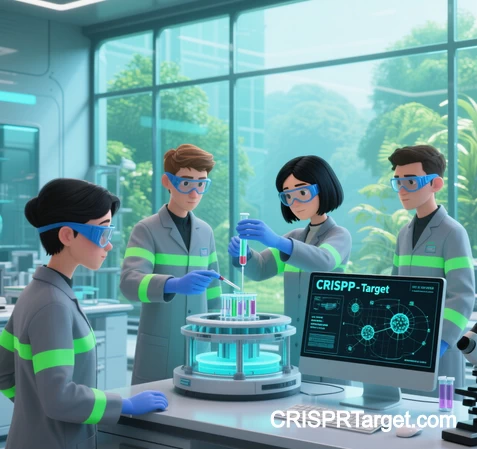 1. Introduction: The Foundation of CRISPR Targeting
1. Introduction: The Foundation of CRISPR Targeting
CRISPR-target design constitutes the cornerstone of effective genome editing, diagnostics, and therapeutic applications. This process involves engineering guide RNAs (gRNAs) to direct CRISPR-associated proteins (e.g., Cas9, Cas12, Cas13) to specific genomic or transcriptomic loci. The core challenge lies in balancing specificity, efficiency, and functionality while minimizing off-target effects. This article delineates the universal design principles derived from computational algorithms, empirical validations, and multi-omics integration.
2. Core Design Principles for gRNA Selection
A. Sequence-Specific Parameters
- Specificity Optimization:
- gRNA sequences (typically 20 nt) must uniquely bind the target site, avoiding homology to unrelated genomic regions (#user-content-1)(#user-content-11).
- Computational screening against reference genomes identifies off-target risks using BLAST or specialized tools like CHOPCHOP (#user-content-10).
- GC Content Balance:
- Ideal GC content ranges between 40–60% to ensure stable hybridization while preventing secondary structure formation (#user-content-1)(#user-content-5).
- Low GC (<30%) reduces binding stability; high GC (>70%) promotes non-specific interactions.
- Avoidance of Problematic Motifs:
- Exclude sequences with:
- Poly-T stretches (≥4 T), which terminate RNA polymerase III transcription (#user-content-1).
- Restriction enzyme sites interfering with cloning (e.g., EcoRI, XbaI) (#user-content-3).
- Repetitive sequences increasing off-target cleavage (#user-content-1).
B. Structural and Functional Considerations
- Target Position within Genes:
- For gene knockouts: Target early exons near the translation start site to maximize frameshift probability (#user-content-1)(#user-content-3).
- For CRISPRa/i: Target promoters (-50 to +300 nt from TSS) or enhancers for optimal epigenetic modulation (#user-content-6).
- Amino Acid-Centric Targeting (Protein Engineering):
- Tools like CRISPR-TAPE enable residue-specific gRNA design by mapping codons to genomic loci, prioritizing cut sites within 30 nt of target residues to boost HDR efficiency (#user-content-8).
- Accessibility to Chromatin:
- Consider chromatin openness (e.g., via ATAC-seq data) and epigenetic marks; closed heterochromatin reduces editing efficiency (#user-content-6).
3. Advanced Algorithmic Prioritization
A. Scoring Systems for gRNA Selection
Modern tools employ multi-parameter scoring:
| Parameter | Optimal Threshold | Impact |
|---|---|---|
| On-target Score | ≥0.4 | Predicts cleavage efficiency |
| Off-target Score | ≥0.67 | Minimizes non-specific binding |
| SNP Probability | ≤0.05 | Reduces population-specific failure |
| Isoform Coverage | >0.5 | Ensures pan-isoform functionality |
Data derived from STEMCELL Technologies’ CRISPR design algorithms (#user-content-5).
B. Machine Learning Integration
- Cas13 gRNA Design: Neural networks predict efficient RNA-targeting gRNAs by training on datasets of guide efficiency for viral genomes or non-coding RNAs (#user-content-9).
- Diagnostic Applications: PathoGD combines conservation analysis and off-target screening to design pathogen-specific gRNAs (e.g., for SARS-CoV-2 S-gene) (#user-content-4).
4. Specialized Applications & Tailored Principles
A. Diagnostic Target Design
- Pathogen Detection:
- Target conserved regions (e.g., nuc in S. aureus) with ≤90% similarity to other species (#user-content-4)(#user-content-10).
- Use CHOPCHOP to filter gRNAs with minimal off-targets against host genomes (#user-content-10).
- Viral Variant Tracking:
- Design gRNAs against mutable regions (e.g., spike protein RBD) paired with backup gRNAs (#user-content-10).
B. Multiplexed Genome Engineering
- CRISPR Arrays: Embed multiple gRNAs in a single transcript using tRNA spacers to coordinate simultaneous edits (#user-content-12).
- Spatial Constraints: For base editing, ensure target nucleotide resides within the enzyme’s activity window (e.g., 3–8 nt for BE4) (#user-content-8).
C. In Vivo Therapeutic Delivery
- Nanoparticle Integration: Optimize gRNA length (<23 nt) and secondary structure (ΔG > -5 kcal/mol) for encapsulation in lipid nanoparticles (#user-content-9).
5. Workflow Integration & Experimental Validation
A. Computational Design Pipeline
B. In Vitro Validation Steps
- On-target Efficiency: T7E1 assay or NGS quantification of indels.
- Off-target Profiling: GUIDE-seq or CIRCLE-seq for genome-wide cleavage mapping.
- Functional Verification: Phenotypic assays (e.g., protein knockout via Western blot).
6. Emerging Frontiers & Future Directions
A. Single-Cell gRNA Design
- Integrate scRNA-seq data to target cell-state-specific enhancers or isoforms (#user-content-8).
B. Quantum Computing Optimization
- Predict RNA folding kinetics or Cas9-binding affinity using quantum annealing (#user-content-5).
C. De Novo Protein Targeting
- Extend CRISPR-TAPE principles to target post-translational modification sites via proximity-based gRNA pairing (#user-content-8).
Conclusion
CRISPR-target design transcends basic sequence matching, evolving into a multidimensional optimization problem governed by:
- Sequence Integrity: Balancing GC content, avoiding repeats and termination signals.
- Functional Precision: Residue-centric cutting for protein engineering, epigenetic modulation for gene regulation.
- Context Awareness: Chromatin states, isoform diversity, and cellular environments.
Advances in machine learning and protein-centric algorithms will soon enable de novo design of gRNAs for undruggable targets, accelerating precision medicine from bench to bedside.
Data Source: Publicly available references.
Contact: chuanchuan810@gmail.com




